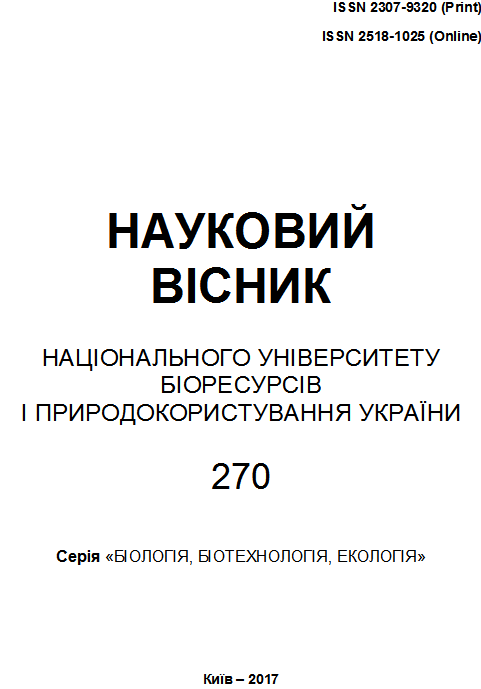STAPHYLOCOCCUS AUREUS AND FUNGI OF GENUS CANDIDA SENSITIVITY TO ADAMANTYL-BASED DERIVATIVES OF AMINOPROPANOL-2
Анотація
The aim of the study was to determine the sensitivity of the museum and clinical strains of staphylococci and fungi of the genus Candida to 27 new adamantylbased derivatives of aminopropanol-2. An antibacterial and antimycotic action of the substances was evaluated according to the minimum inhibitory concentration (MIC) and to the minimum bactericidal or fungicidal concentrations (MBcC or MFcC), which were determined by the micro-method of sequential serial dilutions in a liquid nutrient medium. A museum strain and 10 clinical isolates of Staphylococcus aureus, as well as 5 museum strains and 6 clinical isolates of fungi of the genus Candida are used in the study. As a result of the studies, the significant antimycotic properties in compounds №№1, 6, 10, and 23 were revealed. The MIC of these substances in relation to the museum strains and clinical isolates of Candida species were in the range from 7.8μg/ml to 62.5μg/ml. Substances №6 and №10 showed a moderate effect on staphylococci also. The MIC of compounds, highly active against museum test strains of microorganisms in most cases were equal to the value of the MIC of these substances for clinical isolates of staphylococci and fungi of the genus Candida. Analysis of the antimicrobial activity of substances depending on their chemical structure allowed to put forward a number of assumptions about the influence of some radicals on the presence of antimicrobial properties in the investigated substances.
Посилання
Michael, C. A., Michael, C. A., Dominey-Howes, D., Labbate, M. (2014). The antimicrobial resistance crisis: causes, consequences, and management. Front Public Health, 2, 145. doi: 10.3389/fpubh.2014.00145. e
Glumcher F. S., Dubrov S. A., Kuchin Yu. L. (2014). Plyrezistentnaja infekcija: aktualnost, opredelenue, mehanizmi, naibolee rasprostranjennie patogeni, ktchenie, profilaktika [Multiresistance infection: relevance, definition, mechanisms, most common pathogens, treatment, prevention]. Science and practice, 1 (2),129 – 149.
Lamoureux, G., Artavia, G. (2010). Use of the adamantane structure in medicinal chemistry. Curr. Med. Chem., 17, 2967–2978. doi:10.2174/092986710792065027
Grillaud, M., Bianco, A. Multifunctional adamantane derivatives as new scaffolds for the multipresentation of bioactive peptides (2015). J. Pept. Sci, 21(5), 330–345. doi: 10.1002/psc.2719.e
Liu, J., Obando, D., Liao, V., Lifa, T., Codd, R. (2011). The many faces of the adamantyl group in drug design. European Journal of Medicinal Chemistry, 46, 1949-1963. doi: 10.1016/j.ejmech.2011.01.047.e
Wanka, L., Iqbal, K., Schreiner, P.R. (2013). The lipophilic bullet hits the targets: medicinal chemistry of adamantane derivatives. Chem. Rev., 113, P. 3516–3604. doi: 10.1021/cr100264t.e
Bagrij E. I. (1989). Adamantani: poluchenie, svojstva, primenenie [Adamantanes: Getting, Properties, Application]. Moscow, Russia: Science, 264.
Balzarini, J., Pannecouque, C., De Clercq, E., Pavlov, A.Y., Printsevskaya, S.S., Miroshnikova, O.V., Reznikova, M.I., Preobrazhenskaya, M. N. (2003). Antiretroviral activity of semisynthetic derivatives of glycopeptide antibiotics. J. Med. Chem., 46, N (13), 2755-2764.doi:10.1021/jm0300882.e
Korotkij Yu. V., Vrinchanu N. A., Maximov Yu. N., Lozickij M. O. (2011). Sintez, antimikrobnaja i protivogribkovaja aktivnost chetvertichnih solej adamantancoderzashchih alkoksidialkil aminopropanolov [Synthesis, antimicrobial and antifungal activity of quaternary salts of adamantane-containing alkoxydialkyl aminopropanols] Chem. Pharm. Journal, 1(45), 21-23.
Wang, J. J., Wang, S.S., Lee, C.F., Chung, M.A., Chern, Y.T. (1997). In vitro antitumor and antimicrobial activities of N-substituents of mabeimide by adamantine and diamantine. J. Chemother., 43 (3),182-189.
Vrinchanu N. A., Pokas E. V., Maximov Yu. N. (2003). Antifungalnoe dejstvie 4-adamantil-1-(1-aminobutil) benzola v otnoshenii klinicheskih shtammov gribov [Antifungal action of 4-adamantyl-1- (1-aminobutyl) benzene in relation to clinical fungi strains]. J. Infection Pathology, 10 (4), 33-34.
Korotkij Yu. V., Vrinchanu N. A., Dronova M. L., Suvorova Z. S., Smertenko O.A. (2015). Sintez, antibakterialna ta antifungalna aktivnist pohidnih 1|4 (1,1,3,3, tetrametilbutil) fenozi|3 dialkilamino 2 propanolu [Synthesis, antibacterial and antifungal activity of derivatives 1|4 (1,1,3,3, tetramethylbutyl) phenoxy|3-dialkylamino-2-propanol]. Pharm. J., 1, 56-62.
Voljanskij Yu. L., Gricenko I. S., Shirobokov V. P., Dubinina N. V., et al. (2004). Vivchennja specifichnoi aktivnosti protimikrobnich likarskih zasobiv [Study of specific activity of antimicrobial drugs] Metodical recomendations. Kiev, 38.
Voloshchuk O. M., Korotkij Yu. V., Shirobokov V. P., Smertenko O.A. (2014). Antimikrobnie svojstva novih sintezirovannih soedinenij oxiaminiproizvodnih alociclicheskih i nasishennih geterociklicheskih kondensirovannih sistem [Antimicrobial properties of new synthesized compounds of oxyamine derivatives of alicyclic and saturated heterocyclic condensed systems]. Collection of materials of the international scientific conference. Modern studies of medical and biological sciences. (Электронный ресурс). Moscow (Russia), 87-95.
Завантаження
Опубліковано
Номер
Розділ
Ліцензія
Стосунки між правовласниками і користувачами регулюються на умовах ліцензії Creative Commons Із Зазначенням Авторства – Некомерційна – Поширення На Тих Самих Умовах 4.0 Міжнародна (CC BY-NC-SA 4.0):https://creativecommons.org/licenses/by-nc-sa/4.0/deed.uk
Автори, які публікуються у цьому журналі, погоджуються з наступними умовами:
- Автори залишають за собою право на авторство своєї роботи та передають журналу право першої публікації цієї роботи на умовах ліцензії Creative Commons Attribution License, котра дозволяє іншим особам вільно розповсюджувати опубліковану роботу з обов'язковим посиланням на авторів оригінальної роботи та першу публікацію роботи у цьому журналі.
- Автори мають право укладати самостійні додаткові угоди щодо неексклюзивного розповсюдження роботи у тому вигляді, в якому вона була опублікована цим журналом (наприклад, розміщувати роботу в електронному сховищі установи або публікувати у складі монографії), за умови збереження посилання на першу публікацію роботи у цьому журналі.
- Політика журналу дозволяє і заохочує розміщення авторами в мережі Інтернет (наприклад, у сховищах установ або на особистих веб-сайтах) рукопису роботи, як до подання цього рукопису до редакції, так і під час його редакційного опрацювання, оскільки це сприяє виникненню продуктивної наукової дискусії та позитивно позначається на оперативності та динаміці цитування опублікованої роботи (див.The Effect of Open Access).

